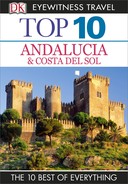Getting Around Andalucia
1. By Bus
If you don’t have your own wheels, the bus system is the best way to get around. Buses go to almost every village, sooner or later, and the roads have improved, shortening routes. There are dozens of companies dividing up the market. You can buy tickets on board.
![]() Seville • Prado de San Sebastian • 954 41 71 11
Seville • Prado de San Sebastian • 954 41 71 11
![]() Seville • Plaza de Armas • 954 90 80 40
Seville • Plaza de Armas • 954 90 80 40
![]() Granada • Ctra de Jaén • 958 18 54 80
Granada • Ctra de Jaén • 958 18 54 80
![]() Córdoba • Glorieta de Tres Culturas s/n • 957 40 40 40
Córdoba • Glorieta de Tres Culturas s/n • 957 40 40 40
![]() Malaga • Paseo de los Tilos • 952 35 00 61
Malaga • Paseo de los Tilos • 952 35 00 61
![]() Almería • Estación Intermodal, Plaza de la Estacion s/n • 950 26 20 98
Almería • Estación Intermodal, Plaza de la Estacion s/n • 950 26 20 98
2. By Train
Train connections between major towns are fairly developed and there are some regional routes as well. Stations in Seville, Córdoba and Málaga are efficient and user-friendly; however, expect many stops along the way.
![]() Seville • Santa Justa, Avda Kansas City
Seville • Santa Justa, Avda Kansas City
![]() Granada • Avda Andaluces
Granada • Avda Andaluces
![]() Córdoba • Glorieta de las Tres Culturas
Córdoba • Glorieta de las Tres Culturas
![]() Malaga • Explanada de la Estación • 902 24 02 02
Malaga • Explanada de la Estación • 902 24 02 02
3. By Metro
The subway system in Seville provides a cost-effective and more efficient means of transport for people based in the outer suburbs to access the centre.![]() www.metro-sevilla.es
www.metro-sevilla.es
4. By Car
Many of the main roads in the region are less than 10 years old and in great condition. The problem is that, as a result, older maps can be confusingly out of date. Expect chaotic driving conditions, as locals pay little attention to rules and signs. Parking in towns and cities can be a real problem – leave the car in a car park and walk.
5. By Motorcycle
This is an excellent way to visit the out of the way areas and to discover a side of the region that most pass by. For steep inclines you’ll need a good-sized bike, but if you’re on the coast a scooter will do. Helmets are required by law.
6. Boating
With all the marinas up and down both coasts this mode of transport is a natural if you can afford it. But you’ll need to be an experienced sailor to deal with the heavy currents that dominate the waters around the Strait of Gibraltar – for most, it’s best to stick close to either coast.![]() Royal Spanish Sailing Federation • 915 19 50 08 • www.rfev.es
Royal Spanish Sailing Federation • 915 19 50 08 • www.rfev.es
7. By Taxi
Taxis are an affordable way to get around towns – you can find plenty of them cruising the streets to be flagged down. All taxis are metered. In Seville, there are fixed fares to and from the airport. It is customary to give the driver a small tip.
![]() Seville • 954 62 22 22
Seville • 954 62 22 22
![]() Granada • 958 28 06 54
Granada • 958 28 06 54
![]() Córdoba • 957 76 44 44
Córdoba • 957 76 44 44
![]() Malaga • 952 33 33 33
Malaga • 952 33 33 33
8. By Bicycle
Cycling is a major sport all over Spain – especially here, where the weather is so conducive. You’ll see enthusiasts on even the steepest mountain roads. In Seville, a city-hall operated bike rental scheme enables a more relaxed ride.![]() Spanish Cycling Federation • 915 40 08 41 • www.rfec.com • www.sevici.es
Spanish Cycling Federation • 915 40 08 41 • www.rfec.com • www.sevici.es
9. Hiking
This is the best way to explore mountainous areas, and there are many local organizations that are able to help you with maps, suggestions and advice. Make sure you have adequate gear.
![]() Federación Española de Deportes de Montaña, Granada • 958 29 13 40 • www.fedamon.com
Federación Española de Deportes de Montaña, Granada • 958 29 13 40 • www.fedamon.com
![]() Nevadensis, C/Verónica, Pampaneira (Granada) • 958 76 31 27 • www.nevadensis.com
Nevadensis, C/Verónica, Pampaneira (Granada) • 958 76 31 27 • www.nevadensis.com
10. Walking
This is the best way to explore Andalucía. All sights are within walking distance and every inch of their historic centres is worth a close look.
